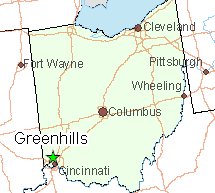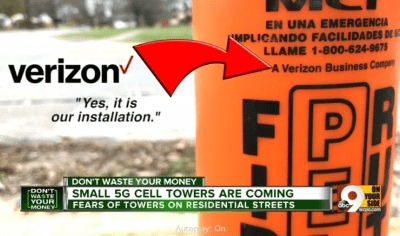 Homeowners in Greenhills, Ohio woke up one morning recently to discover anonymous contractors unspooling cable and planting orange-colored PVC pipes along a Hamilton County right of way on Sharon Road, straddling the communities of Greenhills and Forest Park.
Homeowners in Greenhills, Ohio woke up one morning recently to discover anonymous contractors unspooling cable and planting orange-colored PVC pipes along a Hamilton County right of way on Sharon Road, straddling the communities of Greenhills and Forest Park.
Technological mysteries are uncommon in Greenhills, a planned community built in the 1930s as part of President Franklin Roosevelt’s New Deal program. Greenhills was designed to be surrounded by a “belt” of nature, drawing people out of dilapidated urban settings and into quiet, tree-filled neighborhoods. Many who were offered homes in Greenhills by the Resettlement Administration never left, and their descendents still live in the homes their parents or grandparents once did.
Considering the slow pace of change and the desire to stay a quiet enclave, it should come as no surprise that many residents are disturbed about the quiet invasion of 5G small cells that will be going up all over town, especially because the owner won’t come forward and explain the project.
That layer of secrecy has brought suspicion among neighbors, even those younger ones that understand how much faster 5G service could be over 4G service available today.
 “For me, I’d rather not be the guinea pig,” Andrew Steele told WCPO-TV. “That would be terrible,” Anna Steele, Andrew’s wife, added. “That would be horrible. Also, do we really even need it?”
“For me, I’d rather not be the guinea pig,” Andrew Steele told WCPO-TV. “That would be terrible,” Anna Steele, Andrew’s wife, added. “That would be horrible. Also, do we really even need it?”
A closer inspection of the infrastructure being installed shows Verizon is the most likely silent operator, which makes the prospect of millimeter wave 5G service for the community of 3,600 very likely. That could mean a new home broadband competitor in the area. But many residents do not want an option that includes small cell antennas.
Monique Maisenhalter told the TV station she was concerned about cell tower radiation causing damage to health and the environment, although such evidence is open to debate.
She and nearly 50 of her neighbors have signed a petition asking for the construction to cease until “more is known.”
 Some believe there is no need for 5G service when 4G works well enough. Others are concerned about property values being lowered by the presence of multitudes of small cell antennas. Others object to the fact the equipment is being installed without full disclosure about exactly who is behind it. Even town leaders are flummoxed, as WCPO reports:
Some believe there is no need for 5G service when 4G works well enough. Others are concerned about property values being lowered by the presence of multitudes of small cell antennas. Others object to the fact the equipment is being installed without full disclosure about exactly who is behind it. Even town leaders are flummoxed, as WCPO reports:
The mayor of Greenhills, David Moore, said he has no say over the fiber line installation because the lines are actually going up across the border in Forest Park, on a Hamilton county right-of-way on Sharon Road.
So we went to Hamilton County engineer Ted Hubbard, who said he, too, is struggling to find out who is laying the fiber and what their plan might be.
“The ownership is a big question,” Hubbard said. “And I have asked that. We are having a hard time finding out who actually owns it.”
Hubbard said several small contractors have received permits to install the lines but won’t tell the county who is behind the whole project.
“Who’s going to operate it?” Hubbard asked. “And who do we contact if there is an issue?’
WCPO in Cincinnati investigates mysterious new 5G infrastructure appearing in northern suburbs of Cincinnati (3:19)


 Subscribe
Subscribe Altice USA is upgrading the firmware powering its much-promoted Altice One set-top box to introduce new functionality and integrate popular web services into the viewing experience.
Altice USA is upgrading the firmware powering its much-promoted Altice One set-top box to introduce new functionality and integrate popular web services into the viewing experience. Homeowners in Greenhills, Ohio woke up one morning recently to discover anonymous contractors unspooling cable and planting orange-colored PVC pipes along a Hamilton County right of way on Sharon Road, straddling the communities of Greenhills and Forest Park.
Homeowners in Greenhills, Ohio woke up one morning recently to discover anonymous contractors unspooling cable and planting orange-colored PVC pipes along a Hamilton County right of way on Sharon Road, straddling the communities of Greenhills and Forest Park. “For me, I’d rather not be the guinea pig,” Andrew Steele
“For me, I’d rather not be the guinea pig,” Andrew Steele  Some believe there is no need for 5G service when 4G works well enough. Others are concerned about property values being lowered by the presence of multitudes of small cell antennas. Others object to the fact the equipment is being installed without full disclosure about exactly who is behind it. Even town leaders are flummoxed, as WCPO reports:
Some believe there is no need for 5G service when 4G works well enough. Others are concerned about property values being lowered by the presence of multitudes of small cell antennas. Others object to the fact the equipment is being installed without full disclosure about exactly who is behind it. Even town leaders are flummoxed, as WCPO reports: Cable companies continue to dominate the U.S. broadband marketplace, and the gap between cable broadband and telephone company DSL continues to widen.
Cable companies continue to dominate the U.S. broadband marketplace, and the gap between cable broadband and telephone company DSL continues to widen.
 ast week, saw it briefly restored on Monday, and is out of service once again.
ast week, saw it briefly restored on Monday, and is out of service once again.